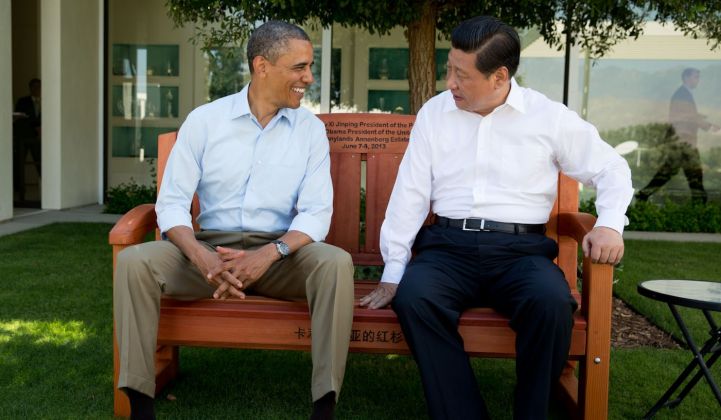Last week, the United States and China announced an historic agreement on climate. China has committed to generating 20 percent of its energy from non-fossil fuel electricity, including nuclear, hydro, solar, biomass, and wind, by 2030. Much commentary has explored whether China’s commitment is ambitious enough, but few if any of these reactions have focused on how China might actually achieve its targets.
First, the Chinese government should be praised for setting its target of 20 percent non-fossil energy by 2030. It is notable that the United States lacks any similar national-scale commitment. The recently announced 20 percent target is on top of China’s existing target of 15 percent renewable energy generation by 2020, as well as the nation’s individual capacity targets for solar (50 gigawatts), wind (200 gigawatts), biomass (30 gigawatts), and hydropower (300 gigawatts). Though it may seem the 2030 target is not ambitious enough given China’s current activities, it is nevertheless important to think about what it will require to meet this target on the ground.
The scale of China’s commitment is impressive. The White House estimates that to produce 20 percent of its energy from non-fossil sources, China will have to install 1,000 gigawatts of new non-fossil capacity by 2030. That’s a United States' worth of generation capacity. It’s the equivalent of installing a 7.5-megawatt wind turbine (the largest land turbine in the world) every hour from now through 2030, or the equivalent of installing one average-sized nuclear plant every six days from now until 2030. That kind of speed and scale represents an incredible undertaking.
The good news, though, is that China installed nearly 62 gigawatts of non-fossil capacity in 2013, which means that if the nation can nudge its non-fossil deployment rate up by just 10 percent and then maintain that rate over the next fifteen years, China can handily meet its newly announced target. So, while the speed and scale are undoubtedly impressive, it is certainly within China’s reach to deploy the generation capacity required for its 2030 commitment.
More grid flexibility is needed
Generation capacity is not necessarily enough for China to meet its 20 percent non-fossil energy target. The grid must be ready to accommodate and deliver the energy produced by all this new non-fossil capacity. Hydro can play a balancing role, but questions remain about how well nuclear and renewable generation can play together. All of these changes highlight the need for more grid flexibility. But China’s grid, which is heavily dependent on coal power (62 percent of installed capacity and 74 percent of generation in 2013), is relatively inflexible and will need modifications to integrate higher shares of non-fossil generation sources (indeed, roughly 21 percent of installed wind capacity was unconnected in 2012).
There are many ways to augment grid flexibility, including upgrading system operations, expanding transmission capacity and widening balancing areas, integrating demand response, deploying energy storage and ramping the existing fossil fleet. These practices are commonly used to match fluctuations in generation with fluctuations in demand in regions with higher shares of renewables. But building this kind of flexibility into China’s grid will require significant investment.
For example, China may require a fundamental shift in how it operates its electric grid. “Contract dispatching” is the name of the game in China, which means grid operators guarantee that specific power plants will run for a fixed number of hours per year, earning a fixed rate that covers the plants’ costs plus a return. As non-fossil generation grows to provide a much larger portion of China’s generation mix, fewer contract hours will be available to existing fossil resources, even against a backdrop of enormous economic growth.
The current contract structure is focused on keeping existing plants profitable (by guaranteeing them hours) rather than minimizing system costs. Several important proposals have been put forward in China to turn this system operations paradigm on its head -- making zero-carbon generation the core and using dispatchable fossil resources to fill in around them while ensuring that old plants are made whole. Steps like these will be crucial complements to China’s overall targets if the nation is to rely on higher shares of non-fossil generation.
Some have claimed that China’s commitment to non-fossil resources is not ambitious enough. Yet China will need to build an amount of non-fossil generation in the next fifteen years that is equivalent to all of its current generation capacity built over the last century. What’s more, integrating this new capacity will require substantial changes to the way China manages its grid, as well as the addition of new resources that can help manage the variability of non-fossil sources.
This commitment sheds light on the need for flexibility on China’s grid, which -- if taken seriously -- can set the stage for much deeper decarbonization beyond its commitment to peak by 2030.
***
Robbie Orvis is a policy analyst at Energy Innovation: Policy & Technology, LLC.



